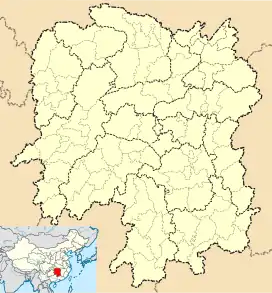Wugang
武冈市 Wukang | |
|---|---|
 Wugang Location in Hunan | |
| Coordinates: 26°43′36″N 110°37′55″E / 26.7266057693°N 110.6319439263°E[1] | |
| Country | People's Republic of China |
| Province | Hunan |
| Prefecture-level city | Shaoyang |
| Area | |
| • County-level city | 1,549.0 km2 (598.1 sq mi) |
| • Urban | 40.00 km2 (15.44 sq mi) |
| Population (2017)[2] | |
| • County-level city | 843,000 |
| • Density | 540/km2 (1,400/sq mi) |
| • Urban | 279,000 |
| Time zone | UTC+8 (China Standard) |
| Postal code | 422400 |
Wugang (simplified Chinese: 武冈; traditional Chinese: 武岡; pinyin: Wǔgāng) is a county-level city in Hunan Province, China. It is under the administration of Shaoyang prefecture-level city. Located on the southwest of the province and middle of Shaoyang's jurisdiction, the city is bordered to the north by Dongkou and Longhui Counties, to the west by Suining County, to the southwest by Chengbu County, to the southeast by Xinning County, to the northeast by Shaoyang County. Wugang City covers 1,539 km2 (594 sq mi), as of the 2010 census, the city had a registered population of 810,003 and a resident population of 734,870;[3] In 2014, it had a registered population of 834,868 and a resident population of 759,312.[4] The city has four subdistricts, 11 towns and three townships under its jurisdiction, the government seat is Shuiximen Subdistrict.[5]
Administrative divisions
- 4 subdistricts
- Faxiangyan (法相岩街道)
- Shuiximen (水西门街道)
- Yingchunting (迎春亭街道)
- Yuanmenkou (辕门口街道)
- 11 towns
- Choushutang (稠树塘镇)
- Dadian (大甸镇)
- Dengjiapu (邓家铺镇)
- Dengyuantai (邓元泰镇)
- Jingzhupu (荆竹铺镇)
- Longxi (龙溪镇)
- Qinqiao (秦桥镇)
- Shuangpai (双牌镇)
- Simachong (司马冲镇)
- Wantouqiao (湾头桥镇)
- Wenping (文坪镇)
- 3 township
- Maping (马坪乡)
- Shuijinping (水浸坪乡)
- Yantian (晏田乡)
Climate
| Climate data for Wugang (1991–2020 normals, extremes 1981–2010) | |||||||||||||
|---|---|---|---|---|---|---|---|---|---|---|---|---|---|
| Month | Jan | Feb | Mar | Apr | May | Jun | Jul | Aug | Sep | Oct | Nov | Dec | Year |
| Mean daily maximum °C (°F) | 8.9 (48.0) |
11.6 (52.9) |
15.8 (60.4) |
22.5 (72.5) |
26.7 (80.1) |
29.5 (85.1) |
32.6 (90.7) |
32.0 (89.6) |
28.2 (82.8) |
22.8 (73.0) |
17.7 (63.9) |
11.7 (53.1) |
21.7 (71.0) |
| Daily mean °C (°F) | 5.6 (42.1) |
7.9 (46.2) |
11.8 (53.2) |
17.8 (64.0) |
22.1 (71.8) |
25.3 (77.5) |
27.7 (81.9) |
27.1 (80.8) |
23.5 (74.3) |
18.4 (65.1) |
13.2 (55.8) |
7.8 (46.0) |
17.4 (63.2) |
| Mean daily minimum °C (°F) | 3.3 (37.9) |
5.4 (41.7) |
9.0 (48.2) |
14.4 (57.9) |
18.7 (65.7) |
22.3 (72.1) |
24.1 (75.4) |
23.6 (74.5) |
20.2 (68.4) |
15.1 (59.2) |
9.9 (49.8) |
4.9 (40.8) |
14.2 (57.6) |
| Average precipitation mm (inches) | 68.7 (2.70) |
71.2 (2.80) |
128.1 (5.04) |
143.2 (5.64) |
172.2 (6.78) |
193.8 (7.63) |
138.2 (5.44) |
134.6 (5.30) |
81.5 (3.21) |
83.0 (3.27) |
72.1 (2.84) |
55.2 (2.17) |
1,341.8 (52.82) |
| Average snowy days | 5.1 | 2.9 | 0.9 | 0 | 0 | 0 | 0 | 0 | 0 | 0 | 0.2 | 1.5 | 10.6 |
| Average relative humidity (%) | 80 | 79 | 81 | 78 | 78 | 80 | 75 | 76 | 77 | 76 | 77 | 76 | 78 |
| Mean monthly sunshine hours | 52.7 | 50.9 | 66.2 | 98.1 | 120.5 | 117.1 | 199.5 | 187.8 | 134.2 | 112.1 | 104.4 | 84.9 | 1,328.4 |
| Percent possible sunshine | 16 | 16 | 18 | 25 | 29 | 28 | 47 | 47 | 37 | 32 | 32 | 26 | 29 |
| Source: China Meteorological Administration[6][7] | |||||||||||||
Language

The Wugang dialect belongs to Xiang Chinese language. The minority languages of Miao people and Yao people are also spoken.
Ethnic groups
Wugang is mostly populated by Xiang-speaking people which is a branch of Han-Chinese.
There are also Miao minority and Yao minority living in Wugang.[8][9] One branch of the Wugang Yao people is known as "Dang" (擋).[10]
Demographics
Wugang has a population of approximately 730,000.
References
- ↑ Google (2014-07-02). "Wugang" (Map). Google Maps. Google. Retrieved 2014-07-02.
- 1 2 Ministry of Housing and Urban-Rural Development, ed. (2019). China Urban Construction Statistical Yearbook 2017. Beijing: China Statistics Press. p. 68. Retrieved 11 January 2020.
- ↑ about the population of Wugang City, according to the comprehensive analysis on the 2010 Population Census of Wugang City (10-Feb-12): 邵阳市2010年第六次全国人口普查主要数据公报, or doc88.com
- ↑ about the population of Wugang City in 2014: 武冈人口
- ↑ about the divisions of Wugang City (December 2, 2015), according to the result on adjustment of township-level administrative divisions of Wugang City on December 2, 2015: rednet.cn: 《湖南省民政厅关于同意武冈市乡镇区划调整方案的批复》(湘民行发〔2015〕119号)
- ↑ 中国气象数据网 – WeatherBk Data (in Simplified Chinese). China Meteorological Administration. Retrieved 23 September 2023.
- ↑ 中国气象数据网 (in Simplified Chinese). China Meteorological Administration. Retrieved 23 September 2023.
- ↑ Original from the University of Michigan Digitized Jul 23, 2011Herold Jacob Wiens (1967). Han Chinese expansion in South China (reprint ed.). Shoe String Press. p. 276. Retrieved March 1, 2012.
- ↑ Herold Jacob Wiens, United States. Office of Naval Research (1952). China's march into the tropics: a discussion of the southward penetration of China's culture, peoples, and political control in relation to the non-Han-Chinese peoples of South China and in the perspective of historical and cultural geography. Defense Technical Information Center. Retrieved March 1, 2012.
- ↑ Richard David Cushman (1970). Rebel haunts and lotus huts: problems in the ethnohistory of the Yao, Part 1. Cornell. p. 111. Retrieved March 1, 2012.